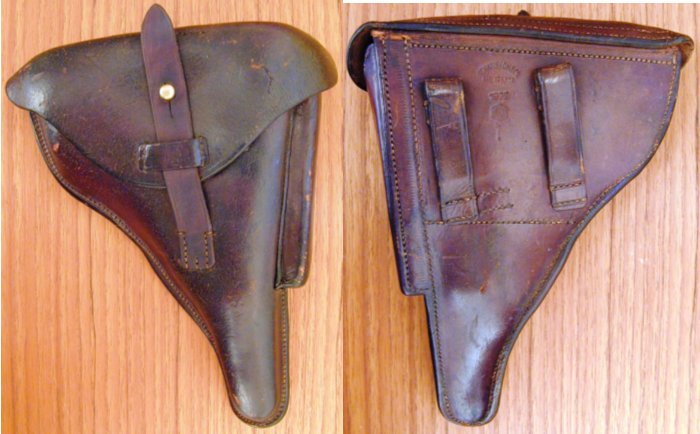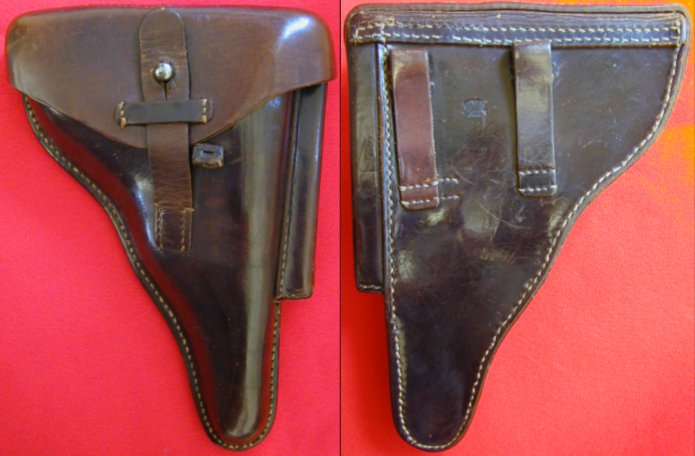
Figure 1: Pre-1925 dark brown leather, commercial/military/police holster type 1 with unusual orange stitching from the LOB Collection.
 Home page
Article created: Saturday, October 15, 2005
Home page
Article created: Saturday, October 15, 2005

The securing strap is of varying width of 20mm at the holster body attaching point to 24mm at its widest. The rear holster body twin belt loops are close together, sewn vertically or parallel to the holster spine and are rather long, being 96 mm in length x 18 mm wide. This holster is identified in current publications as being manufactured in the 1920’s, being associated with 1920’s Weimar Police Lugers. This holster is of original commercial manufacture although its time of manufacture may pre-date the 1920’s, and is possibly of Imperial era origins. One such first style brown leather holster is shown with no maker or other markings whatsoever, commercial or police.
For clarification, there are two manufacturing styles or models of P.08 Luger holsters; pre-1925 and post-1925. Both have tool pouches sewn under the cover flaps and a single magazine pouch sewn to the holster spine. It is the magazine pouch differences that basically define the era of manufacture. The pre-1925 P.08 holster has a complete single three-sided magazine pouch sewn to the holster spine whereas with the post-1925 style P.08 holster, the rear part of the holster body was extended to form the back side of the magazine two-sided magazine pouch.1
Some collectors assert the type 1 dark brown holster was initially an early style Imperial era commercial/military holster. The type 1 “police” holster has been featured and described as such in two earlier publications.2 Actually the subject pre-1925 manufacture holster, shown above in Figure 1, was part of a rig, acquired with an early first issue military 1909 manufacture P.08. In the holster flap loading tool pouch is a crown D stamped loading tool on the front side and on the rear side of the tool the number 1969.
The second or type 2 post-1925 manufacture Police holster pictured below in Figure 2 is identified with the late 1920’s and 1930’s Weimar era and is basically identical to the pre-1925 type 1 except for the “pull up” leather securing strap, which is much longer being 150mm x 20mm wide and is sewn to the holster body by three vertical stitch lines. Additionally, it has different configured twin belt loops being shorter in length, sewn further apart and at an angle to the holster spine, similar to the Imperial era P.08 holster. These holsters are mostly found with makers’ stampings and manufacturing date stamps and with other stampings or IDs unique to late 1920’s and 1930’s police holsters.

The following is a description of an early post-1925 manufactured 1930’s style black leather commercial police holster, type 2 variant with a full bucket flap with aluminum stud with a magazine pouch sewn to the holster body spine. Twin belt loops are sewn to the holster body rear at an angle. The cover flap is secured to the holster body via a leather strap/slit configuration with the closing strap, less the strap leather securing loop attached to the holster body. The type 2 holster style, with the exception of lack of a loading tool pouch in the bucket flap and is otherwise identical to recognized 1930’s Luger police holsters and the arrangement or method of securing the holster cover to the holster body is also identical to 1930’s police holsters less the leather strap securing loop attached to the bucket flap. See Figures 2 and 3.

The subject holster shown in Figure 3 is not a reworked Imperial army holster as the holster bucket flap lacks a loading tool pouch and additionally the makers’ name and location is ink stamped on the inside of the flap. There is also no evidence or remnants of a belt buckle and belt loop.
The leather makers location is ink stamped inside the cover flap: Line one: "Koffer u. Lederwarenfabrik -Zeitz", line two: “S.L.V. - Saale", line three: "Zeitz". On the holster body rear is stamped 1021. There is no provision for a cleaning rod or loading tool. The first line roughly translates to: “Manufacturer of Bags (Suitcases) and Leather wares, Zeitz”, (Germany). “S.L.V. – Saale” is either the manufacturer; Sattlerie-Lieferungs-Verband3 “Saddlers Supply Association – Saale”, with “Saale” or possibly the Association location as “Zeitz” does seem to be the manufacturing location, being mentioned twice in the stamping. There is precedence for Zeitz being a holster manufacturing area as it was the location of possibly the subject holster maker, named “Albin Scholle Lederwarenfabrik, Zeitz”4
This type 2 early police variant holster closely fits the text description found of page 159 of “Weimar and Early Nazi Lugers” by Jan C. Still, with the exception of lacking a loading tool pouch sewn in the bucket flap. “At some point during the early to mid-1920’s (perhaps as early as 1920) the German State Police adapted the stud-strap type closing Luger holster. The first new manufactured holsters lacked the securing loop for the closing strap and those that were examined were unmarked (except for a serial number) and colored black. Those manufactured during the late 1920s’s and early 1930’s were manufactured with the securing loop for the closing strap and are dated and manufacture marked. The Prussian state police Landjägerie holsters were brown and the Schutzpolicei holsters black.
Since the subject type 2 holster early variant lacks a loading tool pouch sewn on the inside cover flap, collectors can argue that it is not a police holster but a commercial holster. This argument cannot be substantiated. This is the first holster pictured, that in all other respects, fits the above published description, which states examples examined were unmarked, yet does not mention the presence or lack of a loading tool pouch. Also, being a type 2 holster suggests post-1925 manufacture based on definitions cited herein.
Abrecht Kind GmbH or AKAH P.08 style commercial holsters similar to the type 2 police holster but with a type 1, 3-sided magazine pouch were also used with police Lugers as shown in Figure 4 below.
